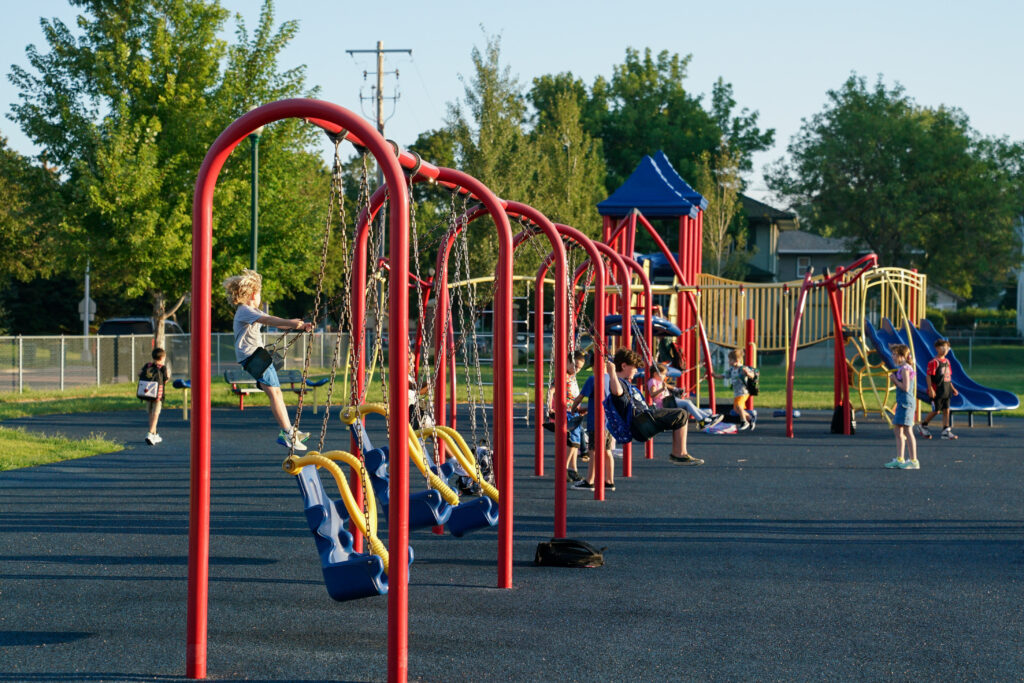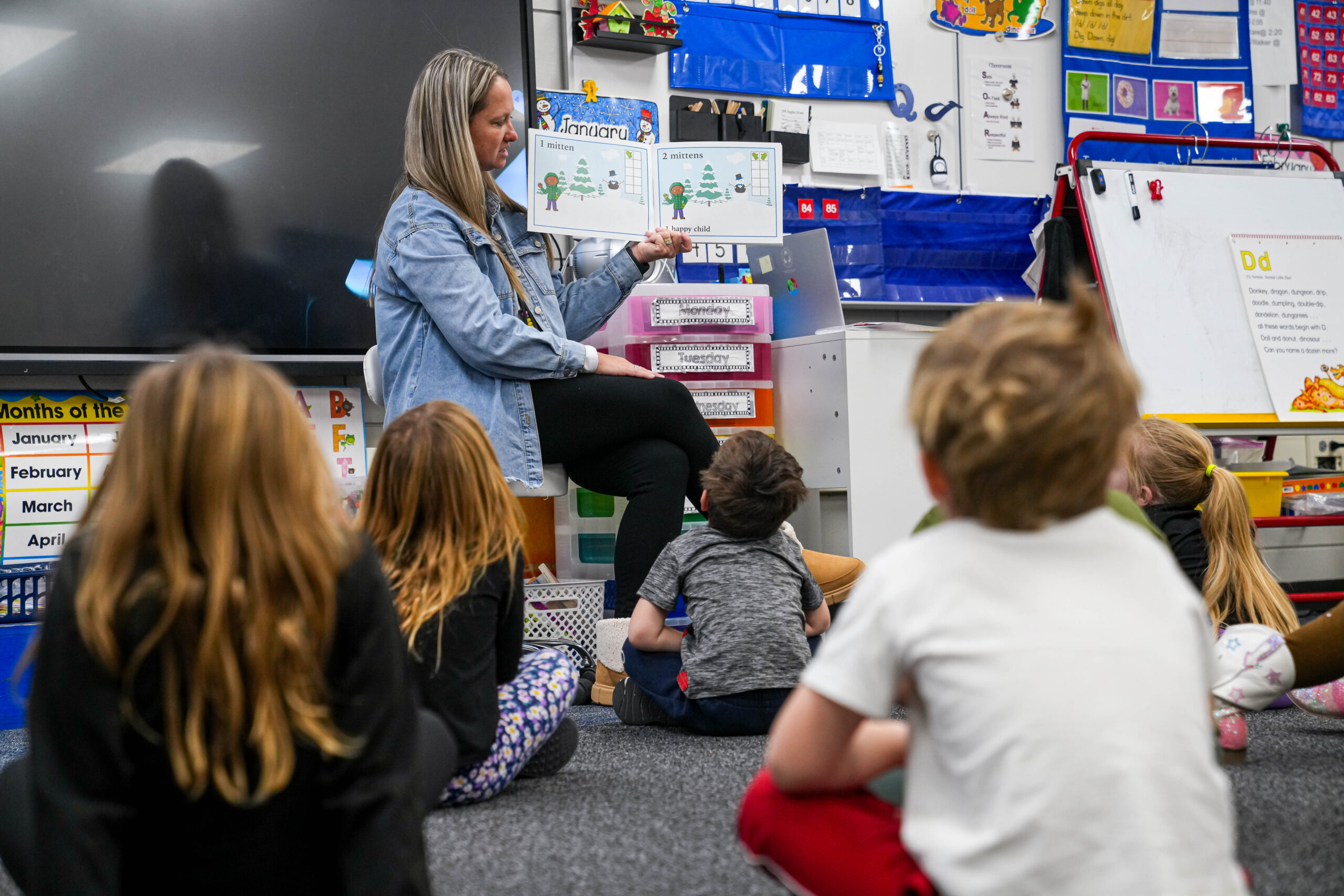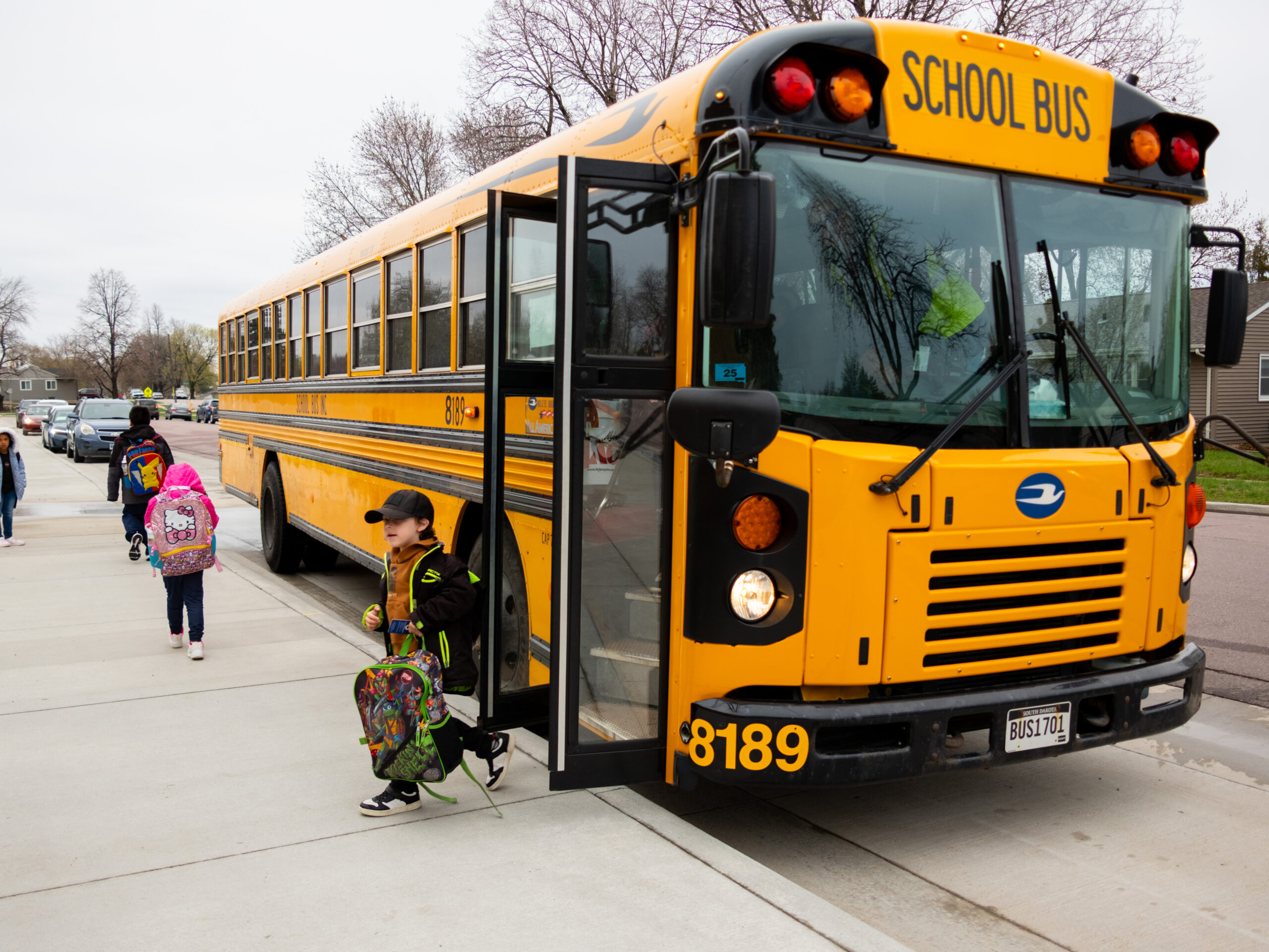
Students in the Sioux Falls School District play on a playground. (Courtesy of Sioux Falls School District)
Teacher contracts were signed in the spring and school district budgets were prepared months ago. But weeks before school starts, South Dakota schools are missing $25.8 million they planned to use for the upcoming school year, according to the state Education Department.
Distribution of congressionally approved funds were paused indefinitely by the U.S. Department of Education on June 30 for review. The department’s decision to withhold $6.8 billion in funds for education triggered alarms nationwide about how the lack of funding will affect hiring of staff as well as student enrichment, after-school and language-learning services.
Trump administration tells states it’s freezing $6.8 billion for K-12 school programs
The funding freeze affects several programs, including Title II-A (educator training and recruitment), Title III-A (English learner support), Title IV-A (student enrichment and after-school programs), migrant education, and adult education and literacy grants.
Sandra Waltman, director of public affairs for the South Dakota Education Association, said school districts are “scrambling” to figure out their budget without the federal funding. That could mean eliminating vacant positions ahead of the school year or dipping into reserves “as long as they can.”
“This undermines the trust the community has in their public schools. This ‘we’re going to give you money but not give you money’ situation makes families question whether their school is going to have the resources to provide an education,” Waltman said. “They might wonder if they should look elsewhere. Maybe that’s the point: to undermine the ability of the public school system to provide support to students who need them.”
Pause could lead to long-term, larger ripple effects
A coalition of Democratic attorneys general and organizations including the National Education Association and National Association for the Advancement of Colored People are challenging the funding freeze in court. The organizations say the administration’s delay is an illegal “impoundment” — a violation of the federal Impoundment Control Act, which bars the executive branch from withholding appropriated funds without congressional approval.
Federal fallout
As federal funding and systems dwindle, states are left to decide how and whether to make up the difference.
The 1974 Impoundment Control Act lets the president propose canceling funds approved by Congress. Lawmakers have 45 days to approve the request; if they don’t, it’s denied. Meanwhile, agencies can be directed not to spend the funds during that time.
South Dakota Education Secretary Joseph Graves said in an emailed statement to South Dakota Searchlight that the funding could continue “without further interruption” once the federal department completes its review.
“The funding pause means that some schools in South Dakota will need to remain flexible as they prepare for the 2025-26 school year,” Graves said. He added that schools still have access to $57 million in some Title I funds, which are primarily used to support schools with a high percentage of students from low-income families. That available funding is the “lion’s share” of federal K-12 education funding in the state.
Waltman said her organization urged South Dakota congressional delegates to “make it clear to the Trump administration that South Dakota schools need these dollars.”
She said the funding freeze will lead to larger consequences.
“If those dollars aren’t restored and we don’t see meaningful investment from the state and federal level, it’ll be difficult for our schools to sustain,” Waltman said. “They’ll look at reducing staff and cutting programs, and some rural schools will struggle to stay open.”
Huron Superintendent Kraig Steinhoff said that the fear, uncertainty and concern because of the funding freeze is “unfortunate and unnecessary.”
“It makes people question whether or not education is going to continue to be supported,” Stenhoff said, “and whether teaching is an occupation people should consider staying in.”
How schools are handling the missing funds
Huron relied on more than $760,000 in what are now frozen funds last school year, Steinhoff said, making it one of the largest recipients in the state. Sioux Falls, Rapid City, Oglala Lakota County and Todd County also receive large amounts of frozen funding.
Oglala Lakota, Sioux Falls and Huron use many of their funds for teacher, counselor and instructional coach salaries.
Sioux Falls, the largest district in the state by number of students, has up to $3.5 million in federal funds affected by the pause.
That’s the equivalent of up to 40 full-time staff, said Kirk Zeeck, Sioux Falls assistant superintendent of academic achievement. About $1.5 million of that funding is used for instructional coaches providing professional development for teachers, including behavioral training and engagement strategies.

Most of the funding on pause at Huron goes toward salaries for extra teachers to reduce the student-to-teacher ratio and staff meant to assist and support students – such as migrant liaisons, summer school staff and paraprofessionals. The funding also goes toward transportation for elementary school students and other programs.
Since staff contracts have already been signed, schools are on the hook to pay for those even though the funding isn’t readily available, Steinhoff added.
For Oglala Lakota County, the paused funding is mostly used to support salaries of instructional coaches and counselors. That includes retention and recruitment bonuses for teachers in one of the most rural and impoverished districts in the state. The annual $1,500 retention bonus is paid out the first pay period of August, said Superintendent Connie Kaltenbach.
“Our district is going to do all we can to ensure we maintain all the funding as best as we can,” Kaltenbach said. “We’ll cinch the belt in other areas.”
If funding isn’t resumed in time, Kaltenbach said the district would likely stop professional development travel and advertising for vacant staff positions. She said she’ll maintain and protect counselor positions in the district “as best we can so students don’t bear the brunt of that.”
Freeze impacts after-school programs: ‘We’re a tool to break the cycle of poverty’
Federal funding for some after-school and summer programs throughout the state is included in the $25.8 million freeze. Those programs, identified as 21st Century Community Learning Centers, are created to provide children, especially low-income students, with a safe place to eat and spend time outside of school areas.
Waltman said families depend on the programs to “fill the gap between after school and when parents can get off work.”
Frozen federal funding accounts for about 40% of the Boys and Girls Club of the Missouri River, according to Executive Director Pat Breen. The award is $246,741 a year, based on fiscal year 2024’s grant documents.
The organization operates the summer and after-school care program for the Wagner Community School District and Marty Indian School. Students are offered afternoon snacks and a meal each day, and they can stay until 8 p.m. during the school year or between 2 p.m. and 7 p.m. on weekdays during the summer.
The programs serve a combined 160 students per day, with more than 1,000 students rotating in and out of those slots last year.
“This is a vital mission,” Breen said. “We’re all about personal accountability and academic enrichment. We’re a tool to break the cycle of poverty.”
Funding for 21st Century programs will be reimbursed by the state Department of Education through August, according to the department. That’s because, since the grant funds cover projects over a five-year period, the department reserved a portion of last year’s awards to cover existing projects.
There are 25 active centers in South Dakota, according to the department.
Sarah Hanson, managing director for children, youth and families at Volunteers of America Dakotas, said the organization’s Kids Campus Central in Sioux Falls is “operating as normal” through mid-August because of the remaining funding from last year. In addition to the program, the organization’s missing $197,309 grant funded a dedicated Science, Technology, Engineering and Math tutor and transportation home for students whose families can’t pick them up.

Hanson said staff are preparing for the possibility they won’t receive funds in time for the new school year. They’re helping families seek other tuition assistance to help the program replace the frozen funding, including state Child Care Assistance, or scholarships.
“Our hope is that by starting early and being proactive, we can limit the number of families who are impacted,” Hanson said in an emailed statement. “Still, the loss of a funding stream this significant will have real effects.”
Hanson said transportation will be offered during the school year regardless of federal funding, because without it, “many families won’t be able to attend at all.”
Keiz Larson, executive director and CEO of YMCA of Rapid City, said her organization was not granted additional funding through August for two after-school programs in Box Elder and Fall River County because the programs restart in August. The YMCA is missing $147,695 between the two programs, based on fiscal year 2024 grant documents.
The after-school program in Box Elder serves the Douglas School District and Ellsworth Air Force Base with care, homework support and enrichment for students. YMCA is the only licensed elementary after-school and summer care provider in the rural Fall River County area, serving Edgemont.
If the frozen funding isn’t released by the end of the week, it could permanently jeopardize care for over 120 families in both communities.
“It’s hard to start something back up after you close it,” Larson said.
Searchlight Senior Reporter John Hult contributed to this article.
Stay up-to-date on state effects from federal funding cuts: Sign up for our free newsletter.


